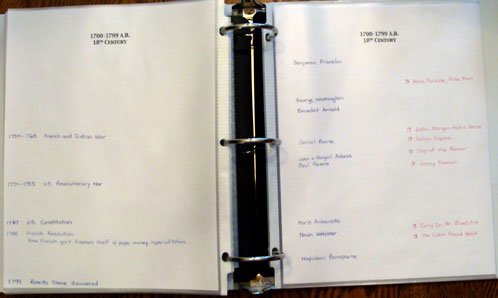Free shipping on USA orders over $129!
How to Use a Book of Centuries
A Book of Centuries can be as unique as you are. I, personally, am a list person, so my Book of Centuries is full of lists. A friend of mine is more of an artistic person, so her Book of Centuries is full of sketches with captions. Both are fine. Give yourself and your children the freedom to create a Book of Centuries that reflects the personal relations you each have made with historical people and events.
If you would like an example of a list person’s Book of Centuries, I’m happy to explain mine in more detail. Just keep in mind that this is not the “right way” or only way to do one.
In my Book of Centuries, the left page is dedicated to specific events with dates that I want to remember. I try to place them on the page chronologically, allowing room to add other events as I come across them. (Remember on the B.C. pages to think backwards. For example, an event that happened in 1295 B.C. would go near the top of the page, while an event that happened in A.D. 1295 would go near the bottom of the page.)
On the right page I list names of people who lived during that era. I’m not a big stickler for exact birth and death dates, so I just list the names and notice who his or her contemporaries were.
Also on that right page, in a different color of ink, I list the titles of any books I’ve read that were set in that time period. They may not necessarily have been written during that century, but if the storyline took place in that era, I list the book. (Those little box-y things next to the book titles are supposed to be little books. That’s about as artsy as I get.)
I’m sure you’ll come up with more ways to personalize your own Book of Centuries. And I hope these ideas will get you thinking about all the possibilities that are waiting in this wonderful timeline tool!
If you would like more information, visit our Book of Centuries page where you can also download a free Book of Centuries template.

